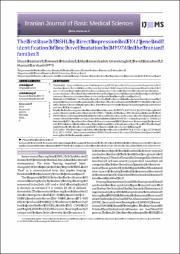The first case of NSHL by direct impression on EYA1 gene and identification of one novel mutation in MYO7A in the Iranian families
(ندگان)پدیدآور
Razmara, EhsanBitarafan, FatemehEsmaeilzadeh-Gharehdaghi, ElikaAlmadani, NavidGarshasbi, Masoudنوع مدرک
TextOriginal Article
زبان مدرک
Englishچکیده
Objective(s): Targeted next-generation sequencing (NGS) provides a consequential opportunity to elucidate genetic factors in known diseases, particularly in profoundly heterogeneous disorders such as non-syndromic hearing loss (NSHL). Hearing impairments could be classified into syndromic and non-syndromic types. This study intended to assess the significance of mutations in these genes to the autosomal recessive/dominant non-syndromic genetic load among Iranian families. Materials and Methods: Two families were involved in this research and two patients were examined by targeted next-generation sequencing. Here we report two novel mutations in the MYO7A and EYA1 genes in two patients detected by targeted NGS. They were confirmed by Sanger sequencing and quantitative real-time PCR techniques. Results: In this investigation, we identified a novel mutation in MYO7A, c.3751G>C, p.A1251PC, p.A1251P, along with another previously identified mutation (c.1708C>T) in one of the cases. This mutation is located in the MYTH4 protein domain which is a pivotal domain for the myosin function. Another finding in this research was a novel de-novo deletion which deletes the entire T) in one of the cases. This mutation is located in the MYTH4 protein domain which is a pivotal domain for the myosin function. Another finding in this research was a novel de-novo deletion which deletes the entire EYA1 coding region (EX1-18 DEL). Mutations in EYA1 gene have been found in branchiootorenal (BOR) syndrome. Interestingly the patient with EYA1 deletion did not show any other additional clinical implications apart from HL. This finding might argue for the sole involvement of EYA1 function in the mechanism of hearing. Conclusion: This investigation exhibited that the novel mutations in MYO7A, c.3751G>C, p.A1251PC, p.A1251P, and EYA1, EX1-18 DEL, were associated with NSHL. Our research increased the mutation spectrum of hearing loss in the Iranian population.
کلید واژگان
EYA1Mutation
MYO7A
MYTH4
NSHL
Genetics
شماره نشریه
3تاریخ نشر
2018-03-011396-12-10
ناشر
Mashhad University of Medical Sciencesسازمان پدید آورنده
Department of Medical Genetics, Faculty of Medical Sciences, Tarbiat Modares University, Tehran, IranDepartment of Medical Genetics, DeNA Laboratory, Tehran, Iran
Department of Medical Genetics, Faculty of Medical Sciences, Tarbiat Modares University, Tehran, Iran
Department of Genetics, Reproductive Biomedicine Research Center, Royan Institute for Reproductive Biomedicine, ACECR, Tehran, Iran
Department of Medical Genetics, Faculty of Medical Sciences, Tarbiat Modares University, Tehran, Iran
شاپا
2008-38662008-3874





